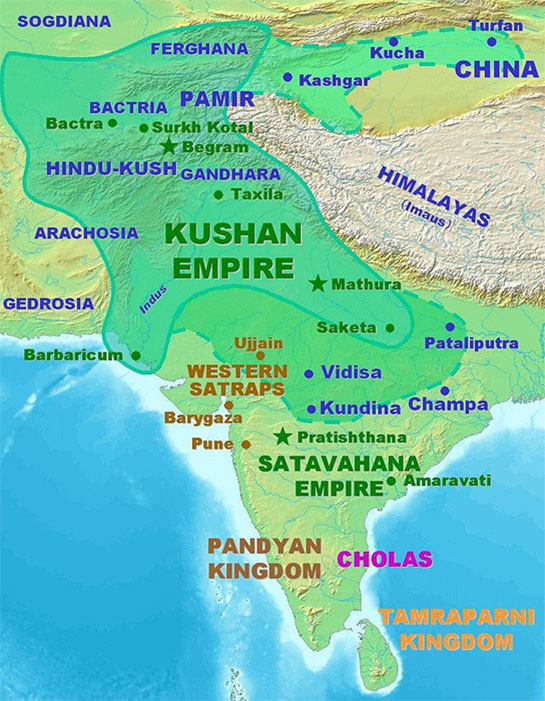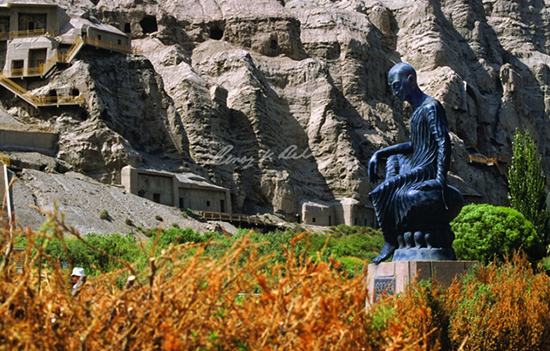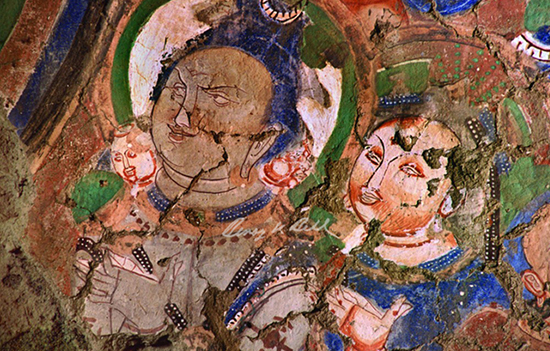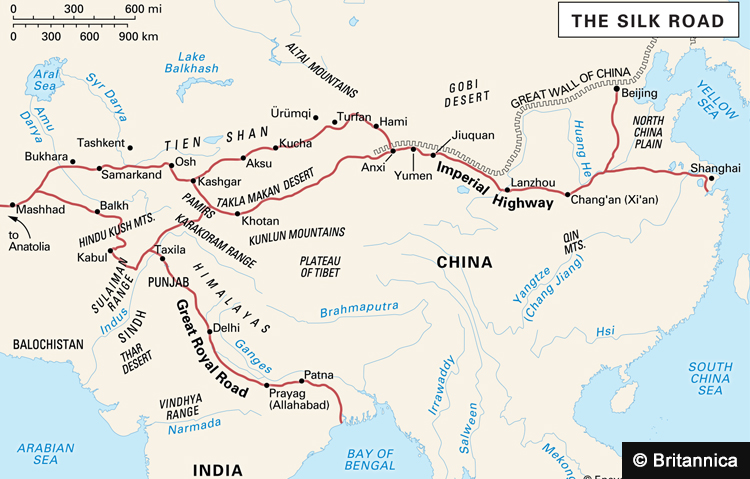Read
about important Buddhist sites in modern day Xinjiang, China.
This was the topic of an International seminar organized by the Bharatiya Vidya Bhavan in New Delhi. Papers presented have now taken the form of a book. We present book introduction in smaller parts. Note “Central Asia is a region in Asia which stretches from the
Caspian Sea in the west to China and Mongolia in the east, and from Afghanistan
and Iran in the south to Russia in the north, including Kazakhstan, Kyrgyzstan, Tajikistan, Turkmenistan, and Uzbekistan-Editor.
A note on the important sites in Central Asia.
 Note locations within India and Central Asia.
Note locations within India and Central Asia.
Kashgar or Kashi (in modern day Xinjiang)
Kashgar or Kashi is an oasis city with
approximately 350,000 residents in the western part of the Xinjiang Uyghur
Autonomous Region of the People's Republic of China. Hsuan-tsang
passed through Kashgar (which he refers to as Ka-sha) in 644 on his
return journey from India
to China. The Buddhist religion, then beginning to decay in India, was active
in Kashgar. He said they had abundant crops, fruits and flowers, wove fine
woolen stuffs and rugs, their writing had been copied from India but their
language was different from that of other countries. The inhabitants were
sincere believers in Buddhism and there were some hundreds of monasteries with
more than 10,000 followers, all members of the Sarvastivadin
School.
Kucha (in modern day Xinjiang)
Kucha
is situated on the banks of river Kucha Dariya. To its northeast is Simsim and
on the two sides in the south of Simsim are Kirish and Achik-ilik. Another site
Subashi is to the north of Kucha and Kizil Kargha to the Northwest on the Kizil
Dariya. Caves and temples of outstanding artistic and architectural importance
once existed in Kucha. Wall paintings depicted a variety of Buddhist subjects
and legends.
Kucha
was a leading city on the northern route, corresponding to Khotan on the
southern route. Its kings bore Indian names, such as Haripuspa, Suvarnapuspa,
Haradeva, Suvarnadeva etc. Valuable remains in substantial number have been
traced from the great monasteries of Kucha. Like art and architecture, the
local literature and curriculum also followed the Indian model. Sanskrit was
methodically taught in the monasteries of Kucha.
The
kingdom of Kucha had 1000 Buddhist stupas and temples and numerous
monasteries and nunneries in the fourth century. Hsuan-tsang has mentioned that
there were five thousand monks in a hundred monasteries. The figures found from
Kucha region are full of a soft and sensuous elegance, enhanced by mild face
expression. There are reminiscent of paintings and sculptures found at
Fondukistan in Afghanistan. A remarkable number of wooden sculptures of 5th
century are also found from Kucha and Tumshuk. Their quality is often superb.
 Statue of Kumarajiva, Kizil
Caves, Kucha, Xinjiang Uygur Autonomous Region, China. Pic
by Benoy K Behl.
Statue of Kumarajiva, Kizil
Caves, Kucha, Xinjiang Uygur Autonomous Region, China. Pic
by Benoy K Behl.
Full caption by Benoy K Behl - Kumarajiva, of the 4th century CE, was the son of the Indian Pandit Kumarayana, the
royal teacher at Kucha. He was married to Princess Jiva of Kucha and their son
was named Kumarajiva, after both their names. At a very young age he was taken
to Kashmir, the land of his father, to learn Sanskrit and Buddhist scriptures.
He returned to Kucha to become the greatest translator of Buddhist texts into
Chinese.
Kizil (in modern day Xinjiang)
75 Kms NW of Kucha, one of the most famous sites in Central Asia, Kizil is situated on the Muzart river, where a multitude of Buddhist temples were discovered, hewn in the mountainsides. The local name for this site ‘Ming-oi’ (1000 cells or chambers) referred to the vague figure of great magnitude.
Approximately 300 caves at Kizil contained frescoes. Their style is said to have evolved in ca AD 500. The paintings look more western and older in comparison to those of Turfan oasis. Scenes portraying sermons delivered by the Buddha were among the famous episodes painted in the monasteries at Kizil. Paintings in the Maya cave display characteristic features of Indo-Iranian style at the peak of its development. Flying figures filling the upper sections exemplify the style found in the Chinese cave complexes.
Life
size figures were parts of larger tableau consisting of several sculptures.
Chopped straw, plant fibers or animal hairs were added to clay to add to their
durability. Some of the 6th century painted clay images were shaped
with the help of stucco molds. Individuality of faces was heightened through
treatment of crowns, hairdos and face expressions. Some of the figures are
predecessors of their Chinese counterparts.
Kumtura (in modern day Xinjiang)
Kumtura
is a small locality to the west of Kucha. The extensive complex of cave temples
of Kumtura lie in a broad valley about twelve and a half miles southeast of
Kizil caves on the lower reaches of Muzart river. Deep ravines cut into these
mountains from the east. On their slopes a number of cave temples have been
found.
Walls of Kumtura caves are covered with paintings in two different styles— Indo-Iranian and East Asian, without any tendency to merge. In some instances Indo-Iranian elements mingle with Chinese Buddhist features. Sometimes facial characterization reflects a distinctly oriental inspiration whereas borders, lotus flowers and portrayal of monks reflect a different style. Paintings in some of these temples belong to the early Indian influence phase while in others they are executed in later T’ang style. But the scenes depicted in paintings, discovered from there are so fragmentary that it is difficult to trace the legends that they represent.
 Shiva and Parvati, Mural, Kizil Caves, Kucha, Xinjiang, c. 6th Century CE, China. Pic
by Benoy K Behl.
Shiva and Parvati, Mural, Kizil Caves, Kucha, Xinjiang, c. 6th Century CE, China. Pic
by Benoy K Behl.
Full
caption by Benoy K Behl - Hindu deities are commonly seen in the art of the
Buddhist caves in India and across the many countries of Asia. We are reminded
of the cosmopolitan culture of ancient times, when Buddhist caves and art were
made in the rule of Hindu kings. Ancient inscriptions also show that the wives
of Hindu kings in India quite often worshipped a Buddha or a Jaina Tirthankara.
Shorchuk and Karashahr (in modern day Xinjiang)
Shorchuk
is a small village to the east of Kucha, halfway towards Turfan. The town of
Korla is to its west and Karashahr, known as Agni-desa, to the east. At the
foot of the mountains stood a whole row of temples in open, which were most
probably destroyed by fire. The site is famous for the most interesting finds
in clay. The figures are Buddhist deities with round faces, designed to fit
into niches, left unmoulded at the back.
Karashahar
was a leading center for propagation of Buddhism in other countries including
China. Its rulers bore Indian names such as Indrarjuna, Chandrarjuna etc. The
Buddhist site Khora near Karashahr has yielded Sanskrit texts of Satapancasika
and catuhsataka, two stotras by Matrceta, written in the Gupta Brahmi
characters.
The nearby cave temples housed extremely interesting manuscripts, murals and clay images of great beauty. Settings inside the caves were constituted by paintings and sculptures, grouped together, around the main image. The figures have full and round faces with pump cheeks, occasionally with a double chin.
 Note location of Kasghar, Kucha,Turfan & Khotan.
Note location of Kasghar, Kucha,Turfan & Khotan.
Turfan (in modern day Xinjiang)
Once Russian merchants reported to the Imperial Academy of Sciences in Petersburg, about the riches of ancient times. Mr. Klementz and his wife discovered significant remains of Buddhist archaeology and for ethnography and philosophy of Central Asia from near Turfan, north of the Terim river in the eastern foothills of the T’ian Shans. They found a whole series of cave temples, full of wall paintings, characterized by Indian, Chinese and Iranian styles. The pictures included Buddhas and Bodhisattvas.
Although
the geographical position made Turfan region more susceptible to cultural
trends from the east than from the west, but there are evidences substantiating
the activities of Indo-Iranian artists. It was not exclusively the region of
Chinese artists. Features of some of the images found from there verify the
works of Indo-Iranian artists at work in Kocho.
The
type of architecture often found in the Turfan region is particularly based on
the so-called pillar or stupa temple in tower form. In such structures there are several square
plinth tiers built one on the top of other and topped by stupa domes.
Varying number of niches to house Buddha images were let into these tiers.
In
the North of Karakhojo, Sengin, Bezeklik, Murtuk and Toyok, cave temples were
cut in soft stone or the cave temples were given a projecting porch of bricks
and wood or a combination of both systems was followed. The style of paintings
is different style in comparison to other sites. Bezeklik was a repository of
caves. When the German expedition reached there in 1905, many of them were
intact.
Near
Murtuk, between the village of Bezeklik and the uppermost part of the Sengin
gorge, to the west of the mountain ridge, is another settlement, called
Chikkan-kul. It consists of a number of caves in a gorge near the large lake.
Buddhist ruins have been found on the shores of the lake and on an island lying
in shallow water. Besides a few damaged paintings, were some very fine heads of
clay statues.
Bezeklik (in modern day Xinjiang)
Among
the most important excavation sites in the Turfan region are the temples of
Bezeklik situated to the south of the village of Murtuk. They are reached by
following the gorge of Sengin northward as far as the point where Murtuk brook
flows into the Sengin river. The high cliffs on the right bank have to be
climbed in order to find a narrow, winding path that leads along the cliff top
to the great monastic complexes of Bezeklik, protected from the unwelcome
visitors. Temples and settlements were built as far as possible from the
profane world. Altogether several hundred temples had been preserved.
The
majority was built in open and was originally joined together by means of
wooden porches. Cave temples hewn in rock also existed there. A whole row of
temples was buried in sand or covered by loess dust, yielded many
well-preserved relics of early cultures.
More
than 80 caves have survived. Forty out of them were decorated with paintings.
The best paintings date from ninth to thirteenth centuries. The paintings are in Indo-Persian and Chinese
styles and represent the Uigur empire at its height. By the tenth century the
area from Gansu province to Khotan was controlled by Uigurs. Bezeklik
flourished as a center for Buddhist learning. Silk Route brought great wealth
to its rulers. The murals celebrate cultural and economic riches of the epoch.
Some
of the murals executed in 7th-8th century exhibit Indian
styles. The wall of the hall of worship, bear paintings from the 9th
century. A fragment of a wall painting from Bezeklik represents Tokharians, who
once populated the oasis towns of the northern and southern sections of the
silk route.
A
number of large paintings were taken to Berlin by the Germans and kept at the
ethnological museum by von Le Coq. They were lost during the second world war
leaving behind only the photographic records.
Other pieces may now be found in various museums around
the world, such as the Hermitage Museum in St. Petersburg, Tokyo National Museum in Japan, the British
Museum in London, and the national museums of Korea and India.
Kocho (in modern day Xinjiang)
30
Kms SE of Turfan, Kocho, a great but ruined city adjoining Karakhoja, was a
forgotten Asian site of extraordinary interest. The inner holy city consisted
only of temples and palaces and was surrounded by a wall measuring 7400 feet.
There were hundreds of tiered temples and grandiose vaulted edifices.
A
large number of figures in wood and clay, woodcuts and murals were rescued by
the German expedition from rubble of temple ruins. The paintings have a
tremendous significance for the history of art for Eastern Asia as they
undoubtedly represent the missing link between ancient Chinese art and the
so-called Grecco-Buddhist art of Gandhara region. Murals were painted in
tempera colors on clay-coated walls. Iconography is derived from Gandhara
sculpture and the style is Chinese.
Votive
stupas in red sand stone can be compared with the ones found in the
caves of Northern Wei in China, dated AD 420-430. Kocho offered manuscripts in many languages
and scripts-Sanskrit, Uigurian, Mongolian, Ancient Turkish, Chinese and
Tibetan. A number of bronzes are also discovered from Kocho.
Kocho was one of the most important halting places for
the travelers belonging to various races and countries. They required books in
different languages and scripts and even bilinguals as aids to communicate. So
in order to serve them manuscripts were written in twenty-four scripts and
seventeen languages. For example there is a manuscript written in Turkish with
Sanskrit glosses in Vertula script. Discovery of pages from illustrated
manuscripts has raised a number of questions related to Buddhist art and
philosophy. Bilingual manuscripts are an important source to study the history
of transmission of Buddhism. According to the German explorers in around 1897
five truck loads of manuscripts illustrated with pictures in colored ink and
gold paint were thrown into river. The story of destruction is painful for the
scholarly world.
Sengin (in modern day Xinjiang)
About
three miles north of Kocho where the Karakhoja river issues from a narrow gorge
lie the temple complex of Sengin. In spite of forbidding character of the
landscape, the left or the western side of the ravine is studded with a line of
temples, whilst the height on the right are occupied by many Indian relic
memorials (stupas). Some of them rise on the very edge of the stream.
Toyok (in modern day Xinjiang)
Extensive complexes of Toyok stood on the southeast of Kocho, carved on the bare side of a mountain range. One of its caves was filled with hundreds of manuscripts. Once somebody tried to destroy the library by fire but was not successful.
Tumshuk (in modern day Xinjiang)
The
main ruins at Tumshuk are discovered from above the hamlet of that name, on the
ridge whose northern end divides into three spurs and parts of the sides of the
massif between them, are covered with ruins of places of worship. A French
expedition was led by Paul Pelliot to investigate these ruins of monasteries
and temples. A German expedition went there under von Le Coq to study the
complexes on the three cliffs to the south.
The
art of Tumshuk was influenced by Indian and Iranian styles. Sometimes the
figures reflect classical Indian art of 5th-6th century, especially of Mathura and Sarnath. Paintings found from there are earlier in date and different in style from Kucha. Many clay objects are also found from there. A variety of Buddha figures are richly painted and overlaid with gold. Some of them were made from molds.
Khotan (in modern day Xinjiang)
The history of cultural symbiosis between India and the kingdom of Khotan goes back to over two millennia. The oasis kingdom of Khotan situated to the south of Taklamakan desert and the massif of Kuen-lun, at the southern end of the Tarim basin, bathed by Yürüng-kash (white jade) and Kara-kash (black jade) rivers. It was an important agriculture and manufacturing center, famous for its silk industry, dance, music, literary pursuits and commercial activities, famous for gold and jade exports.
According to the available accounts in Chinese by Hsüan-tsang himself and by his pupils Hui-li and Yen-tsung, the kingdom was founded by Emperor Asoka’s son Sa-nu and his ministers in 3rd century BC. Hsuan-tsang’s account is contemporary to Gosrnga-vyakarana and his pupils’ to the Prophecy of the Li Country. Hsuan-tsang in his memoirs names it as K’iu-sa-tan-na (breast of earth), formal name used in the region. The Iranians called it Ho-tan and the Indians as Kiu-tan, while it known as Gostana or Gaustana in poetic and literary style in the T’ang period. Tibetans have transcribed the name as Hu-ten, Hiung-nu and Yu-tun etc. but translated as Li-yul.
Khotan flourished uninterruptedly from 3rd century
BC, reign of Sa-nu to AD 1010 under the kings of Vijaya dynasty. The
Tibetan books related to the history of Khotan Gosrnga-vyakarana and Prophecy
of the Li country give an account of the reign of 57 kings who ruled this
prosperous kingdom, built a large number of monasteries for the consolidation
of the state.
Dandan Uilik (in modern day Xinjiang)
About
seventy-five miles northeast of the city of Khotan, was one of the most
important temple cities on the southern Silk Route. In the ruins of the
Buddhist monasteries, crumbling away and buried in the desert sand, manuscripts
and coins from 7th-8th century were found, and also
sculptures in wood and clay. Paintings found from there are significant both
for their subject matter and for iconographic relevance.
Niya and Loulan
Sir
Aurel Stein, the great explorer of the sites of southern Silk Route, found
wooden boards with inscriptions in Kharosthi, dated 263-330, from the temples
of Loulan. Wooden sculptures include Buddhas and Bodhisattvas, devetas, monks,
groups of musicians, and various animals. The local artists have left personal
stamps in them. Wooden relics could survive in Central Asia because they were
desert sand for centuries. Central Asia must have been rich in commercial
timber during the middle of first millennium AD.
Miran
was the capital of ancient city Shan-shan where laity and sramanas practiced
Indian religion; they used Indian books and Indian languages according to
Fa-hien. A large number of wall paintings in the stupa temples witness
the account given by the Chinese traveler. The principal structure at Miran is
a stupa in a circular room. The story of Vessantara Jataka covers the
upper part. Paintings at Miran are known for their optical illusion,
intelligently created by means of line, color combinations and light and shade
effect.
Also read Silk
route trade
Although
no monasteries stand today on the Silk Route, whatever has been discovered, is
fragmentary and spread over in various collections but historically the
material is invaluable because of the light that it throws on the vital role
played by the Silk Route in the eastward transmission of Buddhism.
Author Prof. Dr. Shashibala is Dean, Centre of Indology, Bharatiya Vidya Bhavan, New Delhi.
Also
read
1. The Tarim Basin in Xinjiang was Kashmir’s twin - After being converted to Islam, the
descendants of the previously Buddhist Uyghurs in Turfan soon lost memory of
the origins of the caves.
2. The
Rama Story and Sanskrit in ancient Xinjiang
3. The
Saka Lands linking India and Europe
4. Pictures
of Cultural Documentation (has Buddha and Shiva too) in Central Asia
5. Pictures
of Northern Frontiers of Buddhism (has Mongolia, Buryatia in Siberia)